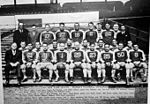Putnam Bridge (New York City)

The Putnam Bridge was a swing bridge that spanned the Harlem River and the adjacent tracks of the New York Central Railroad in New York City. The bridge connected Harlem in Manhattan to Concourse, near the current location of Yankee Stadium, in the Bronx. It carried two tracks of the New York and Putnam Railroad, and later the 9th Avenue elevated line of the Interborough Rapid Transit Company (IRT), as well as two pedestrian walkways outside the superstructure. The bridge opened to rail and pedestrian traffic on May 1, 1881, and operated until all rail service was discontinued on August 31, 1958. The bridge's extreme narrowness of 26 feet (7.9 m) between the centers of the trusses, combined with the proximity of the Macombs Dam Bridge, made it impractical and unnecessary to convert to a roadway bridge, and it was removed in 1960.
Excerpt from the Wikipedia article Putnam Bridge (New York City) (License: CC BY-SA 3.0, Authors, Images).Putnam Bridge (New York City)
Harlem River Drive, New York Manhattan
Geographical coordinates (GPS) Address Nearby Places Show on map
Geographical coordinates (GPS)
| Latitude | Longitude |
|---|---|
| N 40.832222222222 ° | E -73.934444444444 ° |
Address
Harlem River Drive
Harlem River Drive
10035 New York, Manhattan
New York, United States
Open on Google Maps






